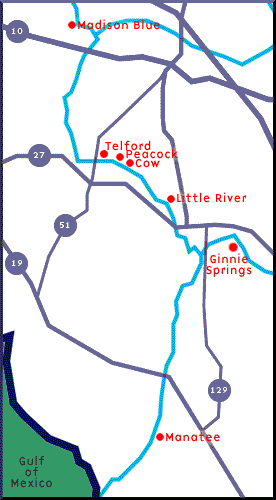The Suwannee River Basin
|
Cave Systems:Manatee Springs |
|
|
by Christopher Werner IntroductionThe Suwannee River originates in the Okeefenokee Swamp of Georgia, flows south into Florida and discharges into the Gulf of Mexico. The Suwannee River Basin is divided into the Upper and Lower Basins. The Upper Basin of the Suwannee River includes subbasins of the Alapaha River, Withlacoochee River, and the upstream Suwannee above the Withlacoochee. The Lower Basin of the Suwannee River includes subbasins of the Santa Fe River and the downstream Suwannee below the Withlacoochee (Ceryak, 1983). |
|
|
The Suwannee River Basin includes two physiographic regions. The Upper Suwannee Basin is developed primarily in the Northern Highlands, while the Lower Suwannee Basin is developed within the Gulf Coastal Lowlands (Ceryak, 1983). The Northern Highlands and the Gulf Coastal Lowlands are separated by the Cody Scrap, which correlates approximately to the 35m topographic contour. The physiographic regions, as well as the Cody Scarp, are dissected by the Suwannee River itself. The floodplain of the Suwannee River is included in the River Valley Lowlands physiographic province. Upstream from White Springs, the Suwannee River is essentially fed by surface runoff, where the River is underlain by as much as 90 m of confining sediments overlying the Floridan Aquifer. Downstream, the river is fed and maintained by carbonate springs as well as surface runoff. Along the Gulf Coastal Lowlands, the Suwannee River flows upon exposed carbonates of the Upper Floridan Aquifer. GeologyMost of the caves within the Suwannee River Basin are developed within the Ocala and Suwannee Limestones. The Ocala Limestone, Eocene in age, forms surface exposures within much of the Lower Suwannee River Basin but does not outcrop in the Upper Suwannee Basin. It is characterized by a white to light gray color limestone, sometimes variably dolomitic and contains a diverse fossil assemblage. These fossils include the foraminifera Lepidocyclina sp. and Nummulites sp., as well as, pelecypods, bryzoans, and gastropods (Arthur, 1991). The Ocala Limestone is overlain by Plio-Pleistocene surficial sand and clay deposits within southern Madison, Lafayette, Dixie, Gilcrest and Levy counties. There are several unconformable contacts in which the Ocala Limestone is overlain by variable thickness of Suwannee Limestone. The Suwannee Limestone, Oligocene in age, pinches out in the northeast against the Ocala Limestone where the Ocala occurs as a stratigraphic high parallel to much of the lower Suwannee River Basin. The Suwannee Limestone is a light to tan gray limestone and tan sucrosic dolostone. The fossil assemblage includes gastropods, pelecypods, and echinoids, as well as benthic foraminifera such as Dictyoconus sp. (Arthur, 1991). The extent of Suwannee Limestone is limited and thin in many places within portions of Suwannee, Lafayette, Dixie, and Levy counties. The St. Marks Limestone (also known as the Tampa Limestone), Miocene in age, is present with the Upper Suwannee River Basin overlying the Suwannee Limestone. The St. Marks Limestone is very limited in its aerial extent, being present in only parts of Madison, Hamilton, Columbia, and eastern Suwannee counties. The St. Marks Limestone is a very pale orange to white, sandy, silty, occasionally fossiliferous limestone. It is usually present only where the Northern Highlands physiographic province is present, and then only underlying Hawthorn and Plio-Pleistocene deposits. It is seen as an erosional remnant east of the Alapaha River and infrequently along the northern Withlacoochee River (Ceryak et. al., 1983). HydrologyThere are three aquifer systems within the Suwannee River Basin: the surficial aquifer, the secondary artesian (Hawthorn) aquifer and the Floridan aquifer (Ceryak et. Al., 1983). The surficial aquifer is developed within the Miocene and Plio-Pleistocene sands. The secondary artesian aquifer is comprised of Hawthorn formation deposits, which include the St. Marks Limestone. This aquifer system is responsible for many of the artesian springs along the Upper Suwannee River Basin which flow down short runs to the Suwannee River. The Floridan aquifer includes both the Suwannee and Ocala Limestones and is responsible for the artesian springs along the Lower Suwannee River Basin. These springs are responsible for supplying much of the flow to the Suwannee River and its tributaries. They provide most of the fresh water to the Santa Fe, Alapaha and Withlacoochee Rivers which drain toward the Suwannee River. Many of the springs have extensive conduits systems. These cave systems concentrate much of the groundwater flow and allow it to discharge directly along the river or at a spring within a few hundred meters of the river. Many of the cave systems like Peacock, Madison Blue and Ginnie, have several main trunk passages and several smaller secondary flow passages. These attributes make these cave systems very complex in terms of flow dynamics and routing during high and low flow conditions. The Suwannee River is known for its frequent flooding episodes. This is a combination of karst river hydrology and complex underground drainage routes. This combination allows very quick integration of groundwater and surface water discharge over a very short period of time, resulting in extensive flooding during the spring months. References
|

